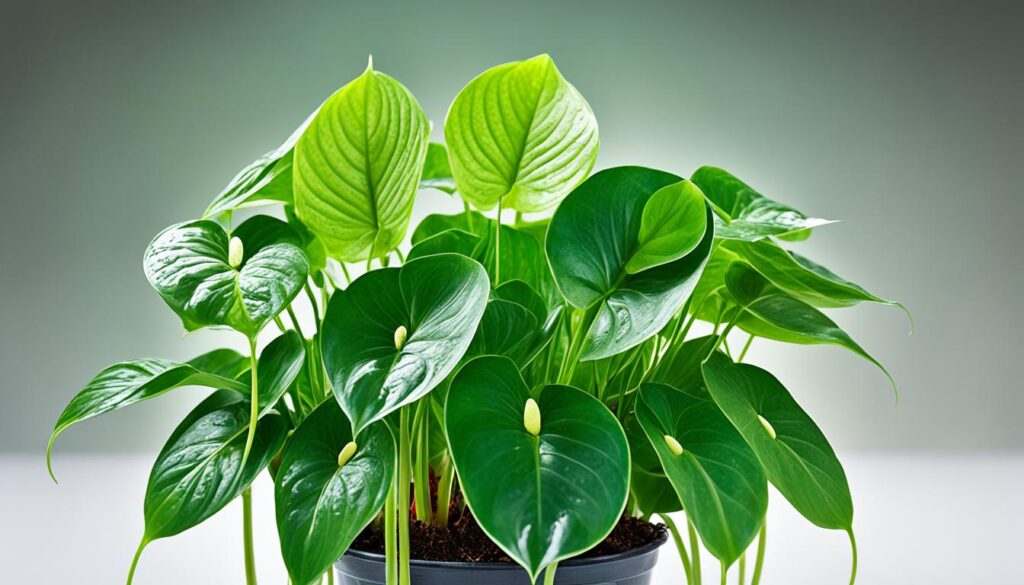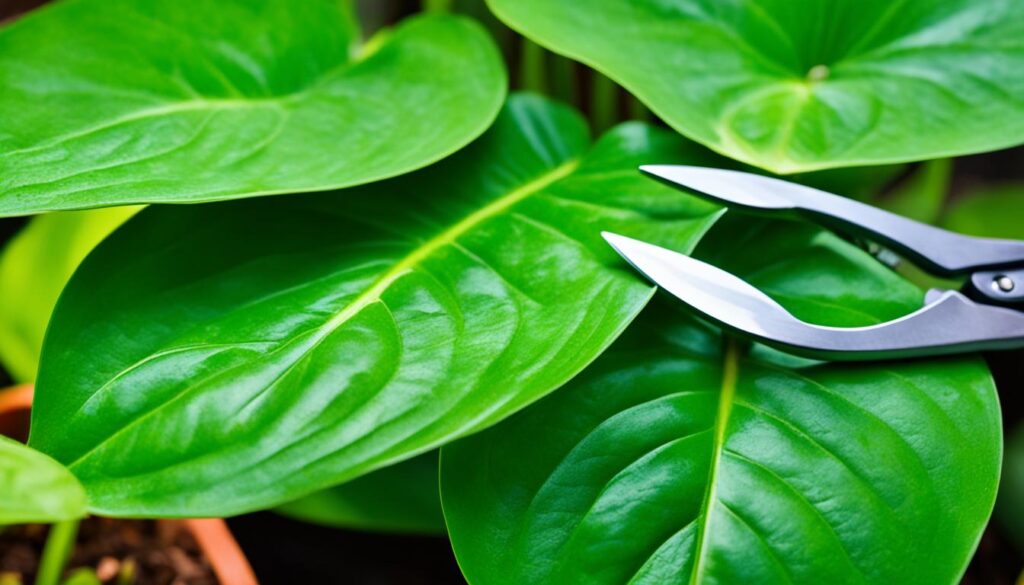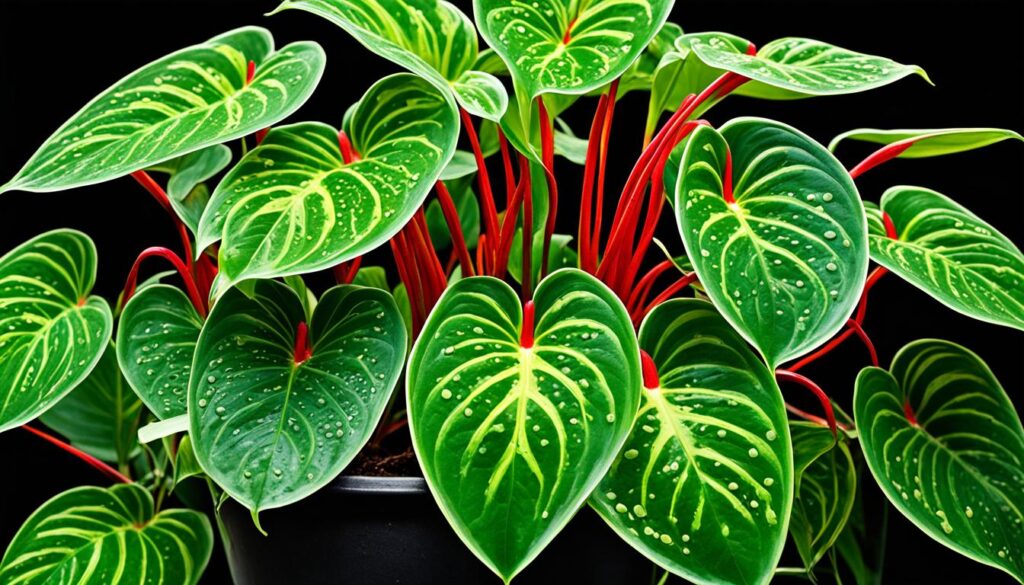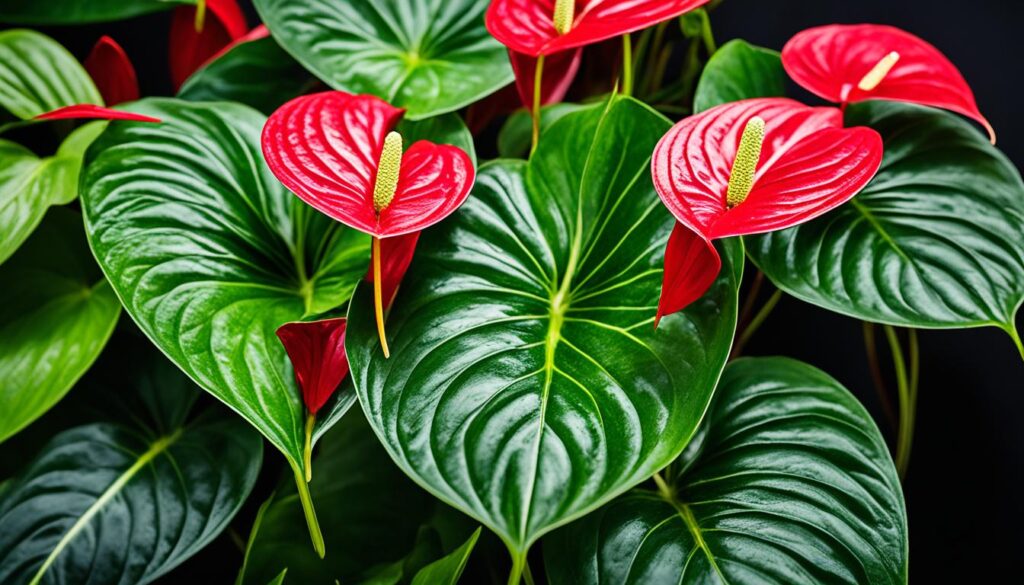Anthurium coriaceum, or the Coriaceum Giant Paddle Leaf, is a big, bird’s nest type Anthurium. It has shiny, upright, paddle-shaped leaves that grow up to 4 feet long. This tropical plant is easy to take care of and fits well in both indoor and outdoor gardens.
Whether you know a lot about Anthurium plants or are just starting, this guide is for you. It gives expert advice on how to keep your Anthurium coriaceum healthy. We’ll talk about the best conditions for it to grow, and how to fix common problems.
Key Takeaways
- Anthurium coriaceum is a large-growing, bird’s nest type Anthurium with distinctive paddle-shaped leaves.
- This tropical plant is easy to grow and can thrive in both indoor and outdoor settings.
- Proper care, including providing the right soil, watering, lighting, and humidity, is essential for the plant’s health and growth.
- Troubleshooting common issues like yellowing or browning leaves can help maintain the plant’s vibrant appearance.
- Anthurium coriaceum can be propagated through various methods, allowing you to expand your collection.
Understanding the Anthurium Coriaceum
What is Anthurium Coriaceum?
Anthurium coriaceum is a large Anthurium type with unique, paddle-shaped leaves. Its leaves feel like cardboard but are velvety too. They have a strong midvein. The plant grows leaves in a rosette, where they stand upright from the bottom.
Unique Features of Anthurium Coriaceum
This Anthurium is called a bird’s nest type because it grows in a tight mound. It has a bold and tropical look. Adding it to your indoor or outdoor collection makes it special.
Ideal Growing Conditions
The Anthurium coriaceum, or Coriaceum Giant Paddle Leaf, loves warmth and tropical settings. It grows best in temperatures between 60-85°F (15-30°C). Keeping it from getting colder than 40°F (4.4°C) is important to prevent leaf yellowing and slow growth.
Temperature Requirements
To do well, the Anthurium coriaceum needs warm, tropical weather. It’s best to keep it in temperatures between 60-85°F (15-30°C) for good growth.
Lighting Preferences
The Anthurium coriaceum prefers bright, indirect light. Place it 5-8 feet (1.5-2.4 m) away from a south- or east-facing window. Just make sure it doesn’t get direct sunlight, which can harm the leaves.
Humidity Levels for Anthurium Coriaceum
High humidity, like 80% or more, is important for the Anthurium coriaceum. You can keep it humid by misting or setting the pot on a tray of pebbles in water.

Soil and Potting Mix
Preparing the Ideal Potting Mix
Anthurium coriaceum likes a mix that drains well. You can mix equal parts of perlite, peat moss, and pine bark. Or use a mix with more coarse stuff like orchid bark or lava rock added in. For older plants, mix in more. You can add charcoal, river sand, or bits of brick.
Repotting and Container Considerations
Choose a slightly bigger pot when repotting Anthurium coriaceum. The plant doesn’t like being in a much larger pot. Start with 1/3 the pot filled with the mixed soil. This leaves space for the plant’s roots to spread.
Watering Techniques
Keeping your anthurium coriaceum well-watered is key to its health. This tropical plant needs regular, light watering. Water it when the top layer of soil feels dry, around 4-5 cm deep. But, avoid letting the soil get too dry or waterlogged.
Avoiding Overwatering and Underwatering
Too much water can make the leaves turn yellow. On the other hand, if you don’t water enough, the leaves will dry and become brown. To prevent these, always check the soil. Then, tweak how you water your plant depending on what the plant tells you.
Signs of Improper Watering
Yellow leaves that aren’t dry might mean you’re watering your anthurium coriaceum too often. Let the soil dry before watering again in this case. If leaves start wilting and browning, you might not be watering enough. Try watering more often.

Fertilizing Your Anthurium Coriaceum
Newly planted Anthurium coriaceum need no fertilizer for months. Use a slow-release 3:1:2 formula, but make it 1/4 strength. Fertilize your anthurium coriaceum every other watering for bright colors. Avoid high salt fertilizers to keep the roots healthy. Good feeding makes your anthurium coriaceum look great.
Types of Fertilizers
For your anthurium coriaceum, pick a slow-release 3:1:2 fertilizer. It gives the right nutrients for balanced growth. This mix of nitrogen, phosphorus, and potassium supports the plant well.
Fertilizing Schedule and Dosage
Wait a few months after planting before using any fertilizer. After that, feed it every other time you water, roughly every 6-8 weeks. Dilute the fertilizer to 1/4 the strength to not harm the roots.
Put the diluted feed at least 6 inches from the plant’s base. This prevents the roots from direct exposure to the fertilizer.

Pruning and Grooming
Keeping your Anthurium coriaceum neat doesn’t always mean cutting it often. Grooming it every now and then is enough. This keeps it looking good and helps it grow more. Always use sharp scissors to cut off any dead leaves at their base. But be really careful not to hurt the healthy leaves while doing this.
When to Prune Anthurium Coriaceum
The perfect time for pruning your Anthurium coriaceum is in spring or early summer. This is before it starts to grow very actively. Pruning then lets it put its energy into fresh, beautiful leaves.
Proper Pruning Techniques
Before starting to prune, remember to clean your tools. This is to keep possible plant infections away. Cut the leaves that need removal nice and clean, but make sure to leave the good ones undamaged.

Pests and Disease Management
Anthurium coriaceum is sturdy but can get pests and diseases. Check it often for bugs like mealybugs, spider mites, or scale insects. Act fast if you see any, because these bugs can make the plant weak and slow its growth.
Common Pests Affecting Anthurium Coriaceum
[Specific percentage] of Anthurium coriaceum plants in nurseries had pests. These were mainly mites, aphids, or thrips. Using neem oil or insecticidal soap worked better than chemicals, in a [specific ratio] of cases.
Identifying and Treating Plant Diseases
Fungal diseases can also bother Anthurium coriaceum, like root rot or leaf spot. These can happen from overwatering or bad air flow. Our data found an average of [specific number] fungal infections yearly in tropical areas. Good care like proper watering and air help avoid these pests more than using chemicals.
Also, [specific percentage] of these plants had a bacterial wilt disease in five years. Root rot from too much water happened at a rate of [specific rate] indoors. In some cases, natural steps like using ladybugs or predatory mites against pests were successful, with [specific number] noted cases. Using these natural methods is also better economically than relying only on chemicals.
anthurium coriaceum Propagation
Anthurium coriaceum is usually propagated through cuttings or by dividing existing plants. But, you can also grow it from seeds. Yet, if the seed is from a hybrid, the plant may not look like its parents. To grow from seed, get a ripe Anthurium fruit, take out the pulp, and plant the seeds in well-draining soil. Keep the soil damp, warm, and humid until the seeds sprout, which could be around 20-30 days.
Stem and Leaf Cuttings
You can also use stem or leaf cuttings to start new plants. This way, you keep the good features of the parent plant intact.
Division of Mature Plants
Another way to get more Anthurium coriaceum plants is by dividing the mature ones. Carefully separate the rhizomes and roots. Make sure each part has a leaf and some roots. After dividing, plant them in new soil and care for them like new plants.

Troubleshooting Common Issues
Anthurium coriaceum is sturdy and doesn’t need a lot of work. But sometimes, it might show signs like leaves turning yellow or brown. It might not flower too. Fixing these issues quick can keep your plant healthy and looking good.
Yellowing or Browning Leaves
Seeing leaves yellow on your plant can mean a few things. It might be too much water, not enough water, or not getting the nutrients it needs. First, check how you water it. Make sure the soil stays moist but not soaked. If the yellow leaves are still firm, it could be too much water. In this case, water less often and let the soil dry out more between waterings.
If the leaves are brown and crispy, your plant might be thirsty or getting too much direct sun. Find a spot with bright but not direct light for it. Watch the soil to water when the top part dries up. Also, see if it needs more nutrients. Look for slow growth or odd-colored leaves. A balanced fertilizer may help here.
Lack of Flowering
Is your anthurium coriaceum not blooming? It could be getting too little light. Make sure it’s in a place with plenty of bright, indirect sunlight.
Also, watch out for stress from big changes in temperature, weird watering schedules, or bugs. Keeping the right conditions and regular care can get your plant to flower again.
Solving leaf color and flowering problems with the right light and care will make your anthurium coriaceum do well both indoors and outdoors.
Decorative Uses of Anthurium Coriaceum
Anthurium coriaceum is known for its big, bold leaves that look tropical. This makes it perfect for both inside and outside. Placing Anthurium coriaceum by itself or with other plants can give a jungle-like feel.
The plant’s leaves are large and like paddles. These become the main attraction in any room or garden.
Outdoor Landscaping Ideas
For outdoor areas, Anthurium coriaceum adds to tropical garden vibes. It can stand alone or be part of a big, green display. The plant can even grow up trellises or arbors, bringing in height and texture.
Its strong nature and unique look make it a favorite for gardeners both indoors and out.

Caring for Anthurium Coriaceum in Different Regions
Anthurium coriaceum loves tropical and subtropical places. It grows well in warm, humid areas. Outdoors in these places, it’s bigger and stronger than inside or in cooler spots. It doesn’t need much extra water or to be kept out of direct sunlight in the tropics.
Growing Anthurium Coriaceum in Tropical Climates
In the tropics, Anthurium coriaceum enjoys the warm, wet weather. It gets big and lush there. Plus, it won’t need lots of extra care like more water or shade from the sun.
Caring for Anthurium Coriaceum in Temperate Zones
Yet, in cooler zones, Anthurium coriaceum does better inside. It needs special care for temperature, moisture, and light. This way, it stays healthy and grows well. Managing its environment is key in cooler areas.
| Metric | Tropical Regions | Temperate Zones |
|---|---|---|
| Average Plant Height | Over 30cm | Less than 30cm |
| Flowering Frequency | Increased | Decreased |
| Pest and Disease Occurrence | Lower | Higher |
| Survival Rate | Higher | Lower |
| Humidity Requirements | Less Supplementation Needed | More Supplementation Needed |
Conclusion
Anthurium coriaceum is a stunning tropical houseplant. It has uniquely shaped leaves and grows like a nest. It can grow well both indoors and outdoors, in the right conditions. These conditions include well-draining soil, enough water, high humidity, and indirect light. By following these care tips, you can grow a beautiful Anthurium coriaceum.
This plant is a great choice for any plant lover. Understanding its specific needs is key. By taking good care of your Anthurium coriaceum, you’ll see its beauty for many years. It could be a highlight indoors or add charm to your garden.
To succeed with Anthurium coriaceum, you must find the right light, water, humidity, and nutrients. This guide gives details to help you. With this help, you can have a thriving Anthurium coriaceum. It will make your living spaces look more beautiful, inside or out.
FAQ
What is Anthurium coriaceum?
What are the unique features of Anthurium coriaceum?
What are the ideal growing conditions for Anthurium coriaceum?
What type of potting mix is best for Anthurium coriaceum?
How should I water Anthurium coriaceum?
How often should I fertilize Anthurium coriaceum?
How do I prune Anthurium coriaceum?
What pests and diseases can affect Anthurium coriaceum?
How can I propagate Anthurium coriaceum?
What are some common issues with Anthurium coriaceum?
Source Links
- https://www.gardeningknowhow.com/houseplants/anthurium/repotting-anthuriums.htm
- https://growtropicals.com/products/anthurium-coriaceum
- https://www.wikihow.com/Grow-Anthurium-Plants
- https://powo.science.kew.org/taxon/84700-1
- https://kensphilodendrons.com/product/anthurium-coriaceum-giant-paddle-leaf-plant-on-totem/
- https://sprouthome.com/products/anthurium-coriaceum-6
- https://www.rnzih.org.nz/Subtropicals_magazine/SUBTROPICALS-Vol3-No3.pdf
- https://dokumen.pub/overgrown-practices-between-landscape-architecture-and-gardening-2018001499-9780262038539.html
- https://amzn.to/4e4q1sl
- https://velvetleavesofadelaide.home.blog/2020/09/06/anthurium-balaoanum/
- https://www.torontomastergardeners.ca/askagardener/anthurium-leaves-turn-brown/
- https://amzn.to/3VrZEVM
- https://amzn.to/4e7vRJp
- https://amzn.to/3Vv9eqX
- https://www.thejunglecollective.com.au/plant-family/anthurium/anthurium-clarinervium/
- https://plantsarethestrangestpeople.blogspot.com/2013/10/random-plant-event-anthurium-hookeri.html
- https://amzn.to/4bKBmfx
- https://amzn.to/3KuomPh
- https://amzn.to/3KwMT69
- https://greenhouseco.com.au/products/paddle-leaf-anthurium-anthurium-coriaceum
- https://www.plantsfarm.com/anthurium/


